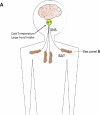Perspective: Does brown fat protect against diseases of aging?
- PMID: 19969105
- PMCID: PMC2818667
- DOI: 10.1016/j.arr.2009.11.004
Perspective: Does brown fat protect against diseases of aging?
Abstract
The most commonly studied laboratory rodents possess a specialized form of fat called brown adipose tissue (BAT) that generates heat to help maintain body temperature in cold environments. In humans, BAT is abundant during embryonic and early postnatal development, but is absent or present in relatively small amounts in adults where it is located in paracervical and supraclavicular regions. BAT cells can 'burn' fatty acid energy substrates to generate heat because they possess large numbers of mitochondria in which oxidative phosphorylation is uncoupled from ATP production as a result of a transmembrane proton leak mediated by uncoupling protein 1 (UCP1). Studies of rodents in which BAT levels are either increased or decreased have revealed a role for BAT in protection against diet-induced obesity. Data suggest that individuals with low levels of BAT are prone to obesity, insulin resistance and cardiovascular disease, whereas those with higher levels of BAT maintain lower body weights and exhibit superior health as they age. BAT levels decrease during aging, and dietary energy restriction increases BAT activity and protects multiple organ systems including the nervous system against age-related dysfunction and degeneration. Future studies in which the effects of specific manipulations of BAT levels and thermogenic activity on disease processes in animal models (diabetes, cardiovascular disease, cancers, neurodegenerative diseases) are determined will establish if and how BAT affects the development and progression of age-related diseases. Data from animal studies suggest that BAT and mitochondrial uncoupling can be targeted for interventions to prevent and treat obesity and age-related diseases. Examples include: diet and lifestyle changes; specific regimens of mild intermittent stress; drugs that stimulate BAT formation and activity; induction of brown adipose cell progenitors in muscle and other tissues; and transplantation of brown adipose cells.
Copyright 2009. Published by Elsevier B.V.
Figures




Similar articles
-
Translational Pharmacology and Physiology of Brown Adipose Tissue in Human Disease and Treatment.Handb Exp Pharmacol. 2019;251:381-424. doi: 10.1007/164_2018_184. Handb Exp Pharmacol. 2019. PMID: 30689089
-
An obesogenic diet impairs uncoupled substrate oxidation and promotes whitening of the brown adipose tissue in rats.J Physiol. 2023 Jan;601(1):69-82. doi: 10.1113/JP283721. Epub 2022 Dec 11. J Physiol. 2023. PMID: 36419345
-
Origins and early development of the concept that brown adipose tissue thermogenesis is linked to energy balance and obesity.Biochimie. 2017 Mar;134:62-70. doi: 10.1016/j.biochi.2016.09.007. Epub 2016 Sep 10. Biochimie. 2017. PMID: 27621146 Review.
-
Brown adipose tissue in humans.Int J Obes (Lond). 2010 Oct;34 Suppl 1:S43-6. doi: 10.1038/ijo.2010.183. Int J Obes (Lond). 2010. PMID: 20935666 Review.
-
[Brown adipose tissue: the body's own weapon against obesity?].Ned Tijdschr Geneeskd. 2013;157(20):A5502. Ned Tijdschr Geneeskd. 2013. PMID: 23676126 Review. Dutch.
Cited by
-
In vivo optical imaging of interscapular brown adipose tissue with (18)F-FDG via Cerenkov luminescence imaging.PLoS One. 2013 Apr 24;8(4):e62007. doi: 10.1371/journal.pone.0062007. Print 2013. PLoS One. 2013. PMID: 23637947 Free PMC article.
-
The role of brown adipose tissue in mediating healthful longevity.J Cardiovasc Aging. 2024 Apr;4(2):17. doi: 10.20517/jca.2024.01. Epub 2024 Apr 27. J Cardiovasc Aging. 2024. PMID: 39119146 Free PMC article.
-
Curcumin analogues as selective fluorescence imaging probes for brown adipose tissue and monitoring browning.Sci Rep. 2015 Aug 13;5:13116. doi: 10.1038/srep13116. Sci Rep. 2015. PMID: 26269357 Free PMC article.
-
Growth hormone receptor (GHR) in AgRP neurons regulates thermogenesis in a sex-specific manner.Geroscience. 2023 Jun;45(3):1745-1759. doi: 10.1007/s11357-023-00726-4. Epub 2023 Jan 12. Geroscience. 2023. PMID: 36633824 Free PMC article.
-
The influence of physical exercise on the generation of TGF-β1, PDGF-AA, and VEGF-A in adipose tissue.Eur J Appl Physiol. 2011 May;111(5):875-81. doi: 10.1007/s00421-010-1693-2. Epub 2010 Oct 23. Eur J Appl Physiol. 2011. PMID: 20972576 Free PMC article.
References
-
- Aleo MD, Lundeen GR, Blackwell DK, Smith WM, Coleman GL, Stadnicki SW, Kluwe WM. Mechanism and implications of brown adipose tissue proliferation in rats and monkeys treated with the thiazolidinedione darglitazone, a potent peroxisome proliferator-activated receptor-gamma agonist. J Pharmacol Exp Ther. 2003;305:1173–1182. - PubMed
-
- Almendro V, Fuster G, Busquets S, Ametller E, Figueras M, Argilés JM, López-Soriano FJ. Effects of IL-15 on rat brown adipose tissue: uncoupling proteins and PPARs. Obesity (Silver Spring) 2008;16:285–289. - PubMed
-
- Amorim BS, Ueta CB, Freitas BC, Nassif RJ, Gouveia CH, Christoffolete MA, Moriscot AS, Lancelloti CL, Llimona F, Barbeiro HV, de Souza HP, Catanozi S, Passarelli M, Aoki MS, Bianco AC, Ribeiro MO. A TRbeta-selective agonist confers resistance to diet-induced obesity. J Endocrinol. 2009;203:291–299. - PMC - PubMed
Publication types
MeSH terms
Substances
Grants and funding
LinkOut - more resources
Full Text Sources
Other Literature Sources
Medical
Research Materials

